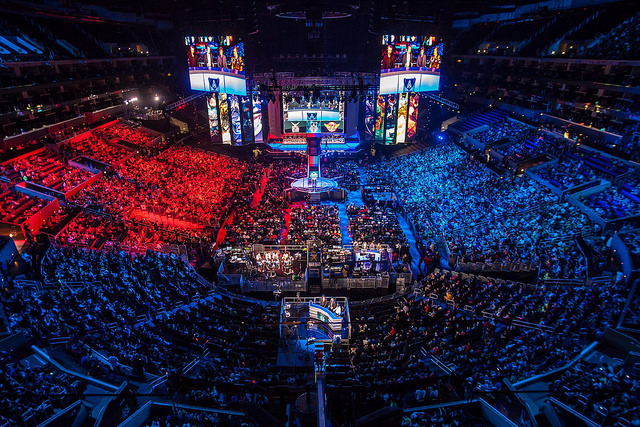The Rise of League of Legends as an eSport
Photo from BagoGames on Flickr
2013 World Championship Finals at the Staples Center, Los Angeles California
Around this time 7 years ago, the first League of Legends (or LoL) World Championship was hosted in Sweden. With only 8 teams (most of them only being formed very recently at that point) the tournament was quite amateur and informal. The camerawork was questionable at best, the interviews lacking, and the crowd (about 200,000 internet viewers, and only 500 live fans) meager compared to other events. However, if we skip forward to modern days, you will see a completely different story.
Just last weekend, the semi-finals for this year’s world championship took place in Gwangju, South Korea. This year’s tournament consists of 24 teams from around the world and has a massive prize pool of 2.25 million dollars. The viewership numbers also continue to break its own record every year, with a reported peak viewer count of 149,058,415 according to analytics website ESC. On top of the colossal amount of people streaming the matches, the stadiums are getting bigger too; the finals will be held in the Incheon Munhak Stadium, which has a capacity of 50,256 people.
So clearly there has been and continues to be a major upward trend in the popularity of the League of Legends eSport, but what is it exactly, and how did it get so big?
League of Legends is an online, multiplayer video game that was created by Californian game company Riot Games. As it is free, it is extremely accessible to anyone interested, with the only real requirement being that they have a computer. In its simplest terms, it is a game where a team of five random players, matched up in real-time, go against another with the objective of destroying the enemies base. However, the game can get extremely complex, and rewards smart decision-making, quick reflexes, and solid teamwork. This means that the game is naturally competitive, and knowing this, Riot Games implemented a system that ‘ranks’ a player based on their skill level.
This competitiveness quickly became a driving factor in the game’s high popularity, with thousands of players starting to play the game every week. Not only did it attract these players, but it also kept them interested, as they continued to improve and achieve higher ranks, with the ultimate goal of reaching the highest level, something which only 0.02% of the player base could achieve. This was the first reason for the game’s success, as many video games are able to draw in players but not keep them.
Naturally, the best players began wanting ways to show their prowess, resulting in a spree of tiny, amateur tournaments to be created. Teams were formed to participate, and thus League of Legends as an eSport, albeit minuscule, was created. Perhaps surprising Riot Games, these tournaments were relatively popular with players, and some teams even began to acquire fanbases. All of this led to the aforementioned first League of Legends World Championships, in which a small European team called Fnatic took home the title.
However, despite the seeming success of the tournament the company did not stop there. They noticed that they had a huge opportunity to expand into Korea and China, where other eSports such as Starcraft had already obtained popularity. This was without a doubt the most influential factor in the game’s current magnitude. LoL was an instant hit, with players already adept at video games quickly learning it and catching up with the Western professional players.
From then on, it was smooth sailing for the game; as the tournaments increased the size, so did the prize pools. As the prize pools increased, so did the quality of life for the pro players. As this happened, more people committed to going pro. It was a massive chain reaction that resulted in a surge of the eSport as a whole. Teams were no longer a group of talented players that wanted to ‘show off’ their play, they were enormous organizations with recognized sponsors such as Red Bull and Logitech and full-time coaches and analysts. With this year’s world finals kicking off this Sunday – Fnatic (now the biggest European team) against Invictus Gaming (an equally popular Chinese powerhouse team), it is expected that yet another record will be broken.





